It’s hard to overestimate the importance of the tram system to Brisbane’s daily life over many decades. In 1930, for example, trams were carrying around 200,000 passengers a day, with the city’s population about 318,000. In this post I’ll look at how trams were a part of our everyday life.
The first trams
The urban area of Brisbane was for decades small enough for most people to commute by foot. By 1863, horse drawn omnibus services had commenced operation as I described in my post Brisbane’s Omnibuses. Twenty years later, rapid growth in Brisbane’s population led a group of investors to decide that the time was ripe to introduce a horse drawn tram service. They formed the Metropolitan Tramway and Investment Company Limited.

The two styles of horse tram introduced in 1885. (Queensland State Archives)
Small single deck and larger two deck trams were introduced. Each car was pulled by two horses, with a third “tip horse” used for steep gradients such as near the dry dock in Stanley Street. The double decker was later described as being the pride of the town.
“It had an open top storey, and well nigh drowned its passengers when it rained. It seated 40, and boasted stumbling, standing, sardine-packed room for 15 more unfortunate travellers.”

Trams in Queen Street, early 1890s. (George Washington Wilson Collection, University of Aberdeen)
Some £100,000 were invested in the tram system, but the company never paid a dividend. The high cost of feeding and caring for the many horses required, combined with lower patronage than expected, meant that it failed to make a profit. Despite the smoother ride, most people who lived near tram lines continued to catch an omnibus or walked to their destination.
Electric trams
In 1895, the Brisbane Tramway Company Limited was incorporated in Great Britain and purchased the assets of the previous company with the intention to convert the system to electric operation. Many of the shareholders were the same. The first electric trams ran down Stanley Street in 1897.
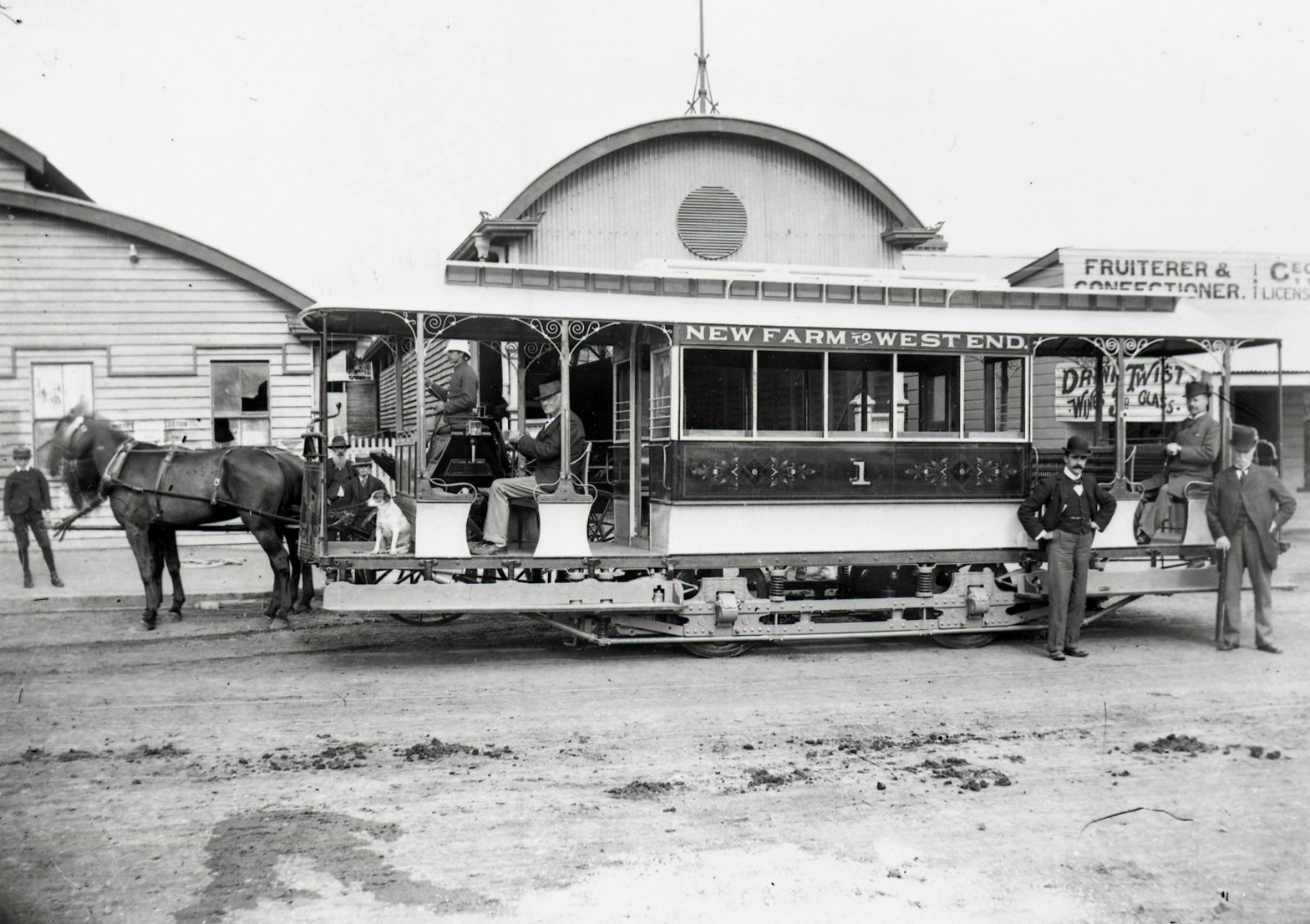
Electric tram number 1, running from West End to New Farm pictured in front of the Logan Road depot. (State Library of Queensland)
Riding on trams
A wide variety of tram types was used in Brisbane each with their own idiosyncrasies from the passengers’ point of view. A 1933 newspaper article described some of these. The first electric trams were said to “sway like galloping camels”. Combination cars, also known as “matchboxes” had “glass doors which opened sympathetically and jammed diabolically”.

A West End “matchbox” tram arrives in Queen Street ca. 1899, as crowds gather for a parade. (Queensland state archives)
The open sides of many of the trams in service over the years were cool in summer but Brisbane’s propensity for heavy and sudden rain meant that passengers got wet, even when largely ineffectual pull down blinds were fitted. A 1919 article commented that “the spectacle of women on the cars, frantically endeavouring to raise their umbrellas to ward of gusts off rain, is not a seldom one“.
In 1928, one journalist commented that in Sydney conductors dried seats with a special towel, but in Brisbane, many travelled standing after rain, “unless some more hardy traveller has kindly absorbed the moisture on his own clothing, perhaps at the cost of a future medical bill”.

Open sided trams were cool in summer but the seats got wet when it rained. (Ray Olsen, Mitchell Library)
In dry periods, unsealed roads often became very dusty, creating another source of passenger discomfort. A 1910 author of a letter to the editor described a recent tram journey –
“On arrival in the city my clothes were in a state that would simply have disgraced a street scavenger. Surely it does not mean that all tram travellers will be reluctantly compelled to don overalls and goggles or some such like dress for the preservation of their wearing apparel.”
There were regular complaints of overcrowding for almost the entire period of operation of the tram system. One newspaper correspondent in 1924 complained that trams were so crowded that to avoid strap hanging, women had to “invade the smoking compartment”.
Crowded trams became more common during World War Two with petrol rationing increasing patronage.

A crowded tram (Courier-Mail)
Brisbane’s trams for long featured hard wooden seats. One car was fitted with cushioned seats as a trial in 1932, but the idea wasn’t progressed as the expense wasn’t deemed necessary. It wasn’t until the last series of trams, introduced in 1939, that padded seats were provided.

Fitting seats to tram 496 at the Brisbane workshops. (State Library of Queensland)
Social norms developed for travel on trams, nicely satirised along with typical characters often encountered, in a 1929 newspaper article that included cartoons.
Tram excursions and recreation
At the time of the introduction of electric trams in Brisbane, private car ownership was extremely rare and few people owned a private carriage. My grandmother told me of how in the pre-World War One years, her family would catch a tram to the Toowong terminus and hike up Mount Coot-tha for a picnic.
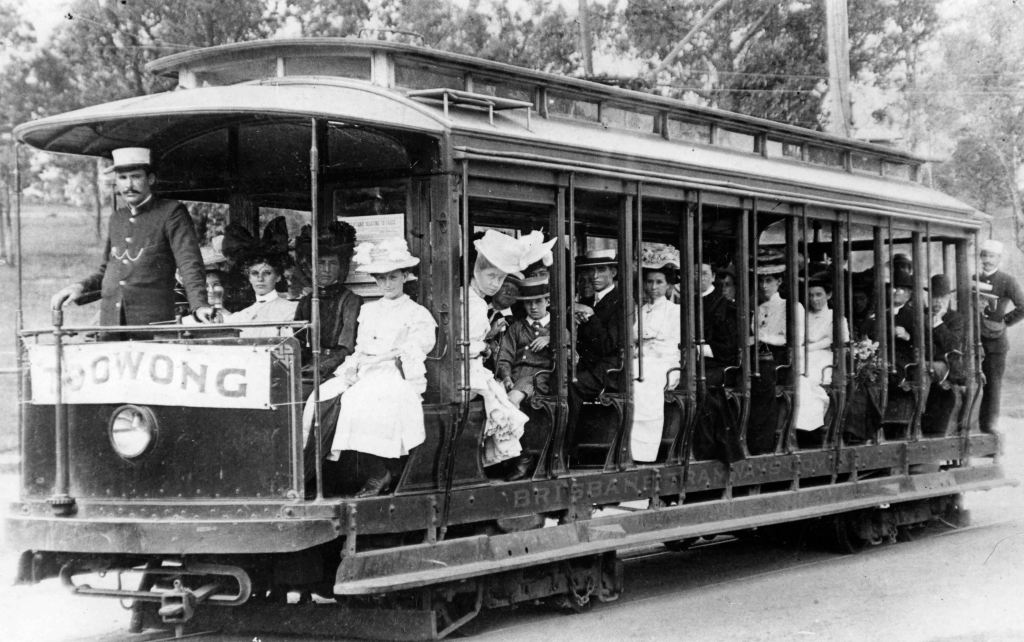

In the first decades of the 20th century, tram excursions organised by the Tramways were popular. These were often linked to fundraising activities. One particularly large event in 1915 was held to raise money for the Patriotic Fund which assisted wounded soldiers. Over 2,500 tickets were sold and 66 tramcars were needed.
Going for a tram trip for pleasure rather than to get to a destination was still common enough in 1923 to have a cartoon published which humorously pointed out what could go wrong.

The perils of taking a pleasure trip on a tram. (Daily Mail, 21st January 1923.)
As motor car ownership increased, these events dropped off in popularity, although individual excursion tickets were still on sale in the 1950s allowing passengers unlimited travel for set periods on Sundays.
Special events
With low levels of car ownership, trams came into their own when large numbers of people wished to travel to special events.
A prime example was the major event of the year in Brisbane, the Royal Queensland Show or Ekka. A spur line down Gregory Terrace to the turnstiles was completed as early as 1899 and in 1923 a loop was added to reduce congestion.

Trams carrying loads of visitors to the Exhibition heading up Brunswick Street to turn into Gregory Terrace, (Fred Ford Collection Queensland Museum)
Similarly, in 1899 a line was extended from the Hamilton terminus down Racecourse Road to the gates of the Ascot Racecourse. A further track was laid along Lancaster Road in 1925 to allow large numbers of trams to be in position to carry race goers home.

Trams waiting on Lancaster Road for the end of the races, date unknown (Trams Downunder)
Trams were also heavily utilised for occasions such as Anzac Day, public holidays, visits by dignitaries and so on.
Accidents
Fatalities started soon after the introduction of horse-drawn trams. There are regular reports of accidents over the years. Many relate to crossing the road in front of a tram, which took some distance to stop.
In 1921, there was a tragic case of a 6 year old girl crossing Vulture Street on her way home from West End State School to Dornoch Terrace. She was hit by a tram and had a leg amputated. Getting on and off trams also resulted in injuries, especially when a passenger attempted to do so whilst the tram was moving.

A West End tram at the Ascot terminus in 1908. (State Library of Queensland)
In the early decades of tram operation, traffic was light and the automobile was yet to make an appearance. Boarding a tram was a casual affair, with passengers walking across both sides of the street.
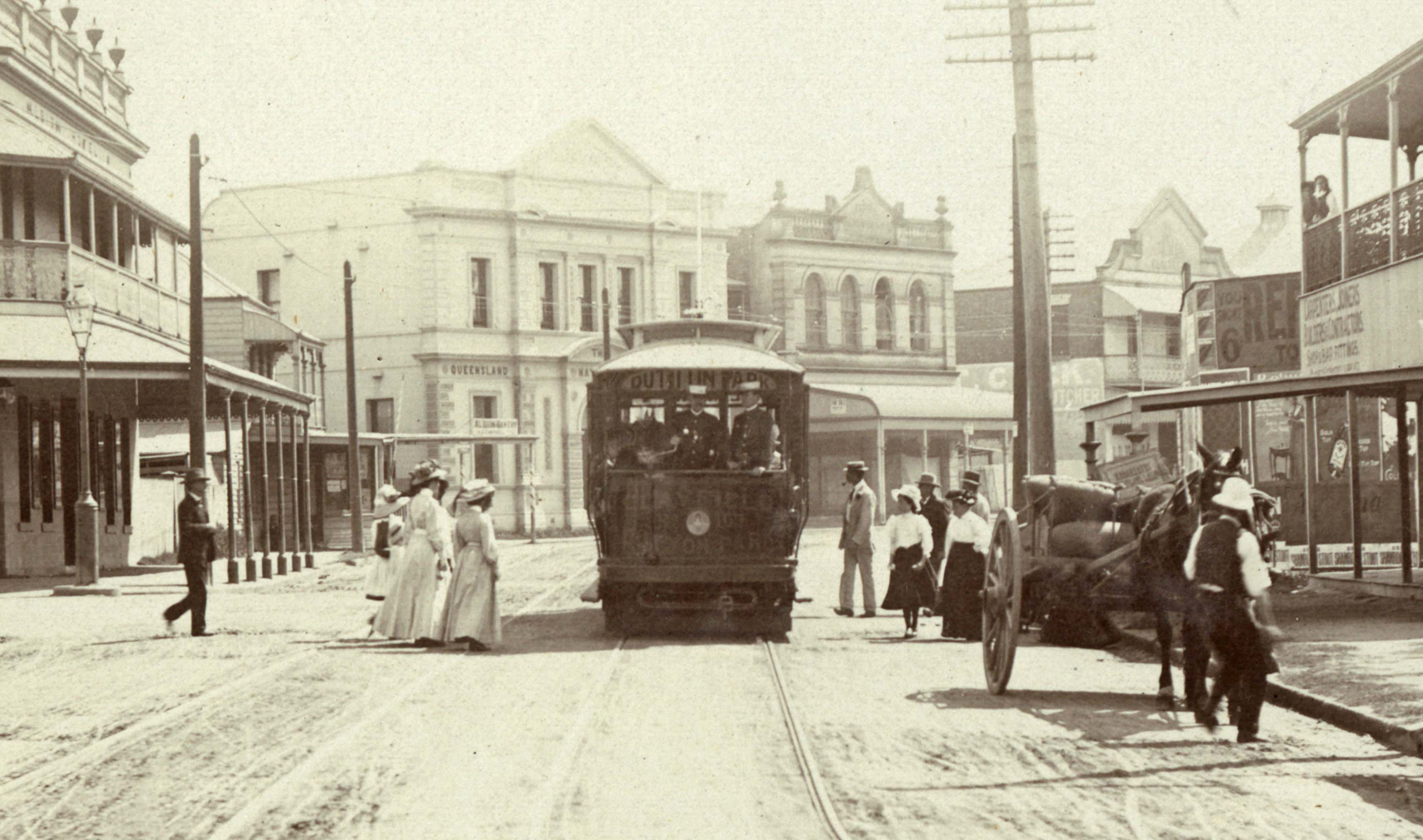
Passengers boarding a Clayfield- Dutton Park tram from both sides of the street at Albion in 1909. (State Library of Queensland)
With increasing vehicular traffic, in 1928 safety zones were finally introduced to Brisbane after a long period of debate. They allowed passengers to cross the street at a safe time and wait for their tram adjacent to where the trams stopped.
It wasn’t long before accidents started to occur, and in 1930 a Hardgrave Road resident died after being hit by a motorcycle while standing in a safety zone in Vulture Street. During the war, there was concern over increasing safety zone accidents with brownouts in place as an air raid precaution (see my post-Brisbane Prepares for Air Raids). At Petrie Bight in 1954, an out of control motorcycle “scattered the men waiting there like ninepins”, sending 6 to hospital with injuries.
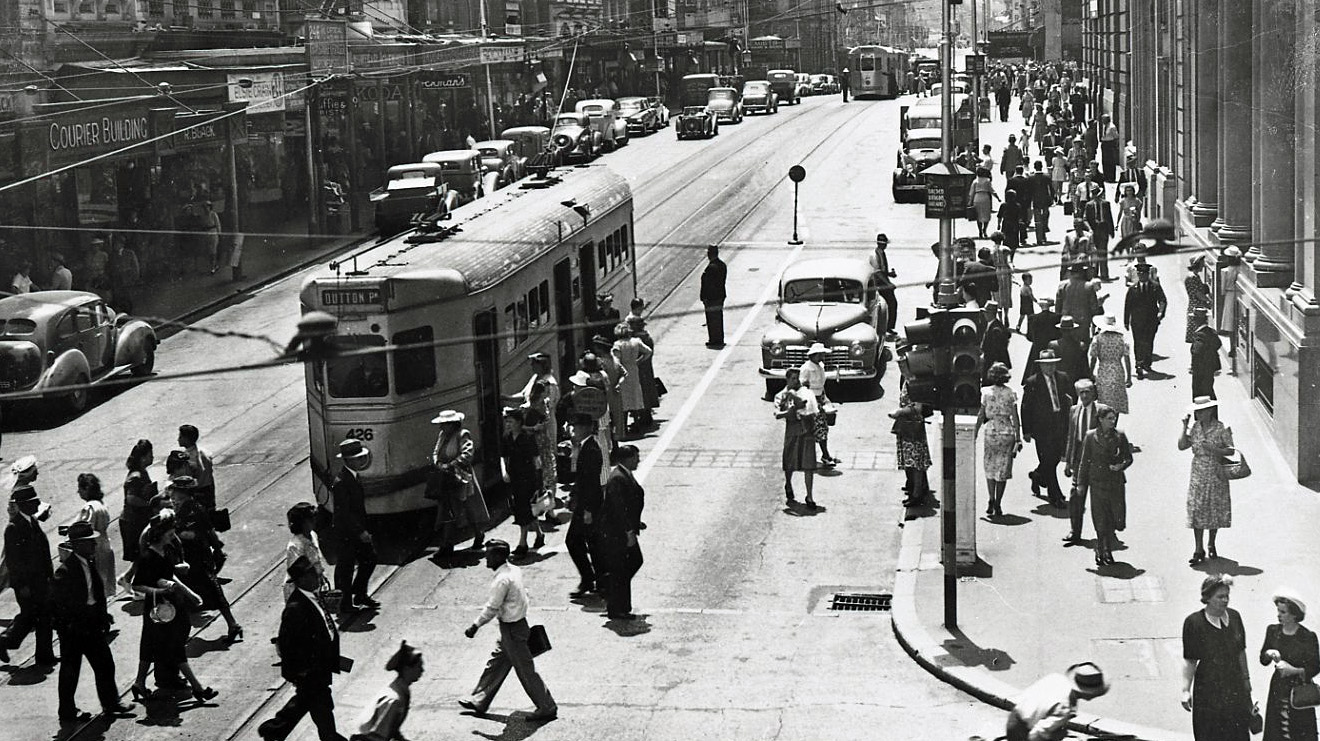
Passengers getting on to a Dutton Park tram from a safety zone in Queen Street in 1946. (Brisbane City Council)
As trams were heavy and required some distance to stop, there were accidents involving other vehicles as well as pedestrians. Drivers had to be especially cautious passing between trams and stopping where a tram might hit the vehicle coming around a corner.
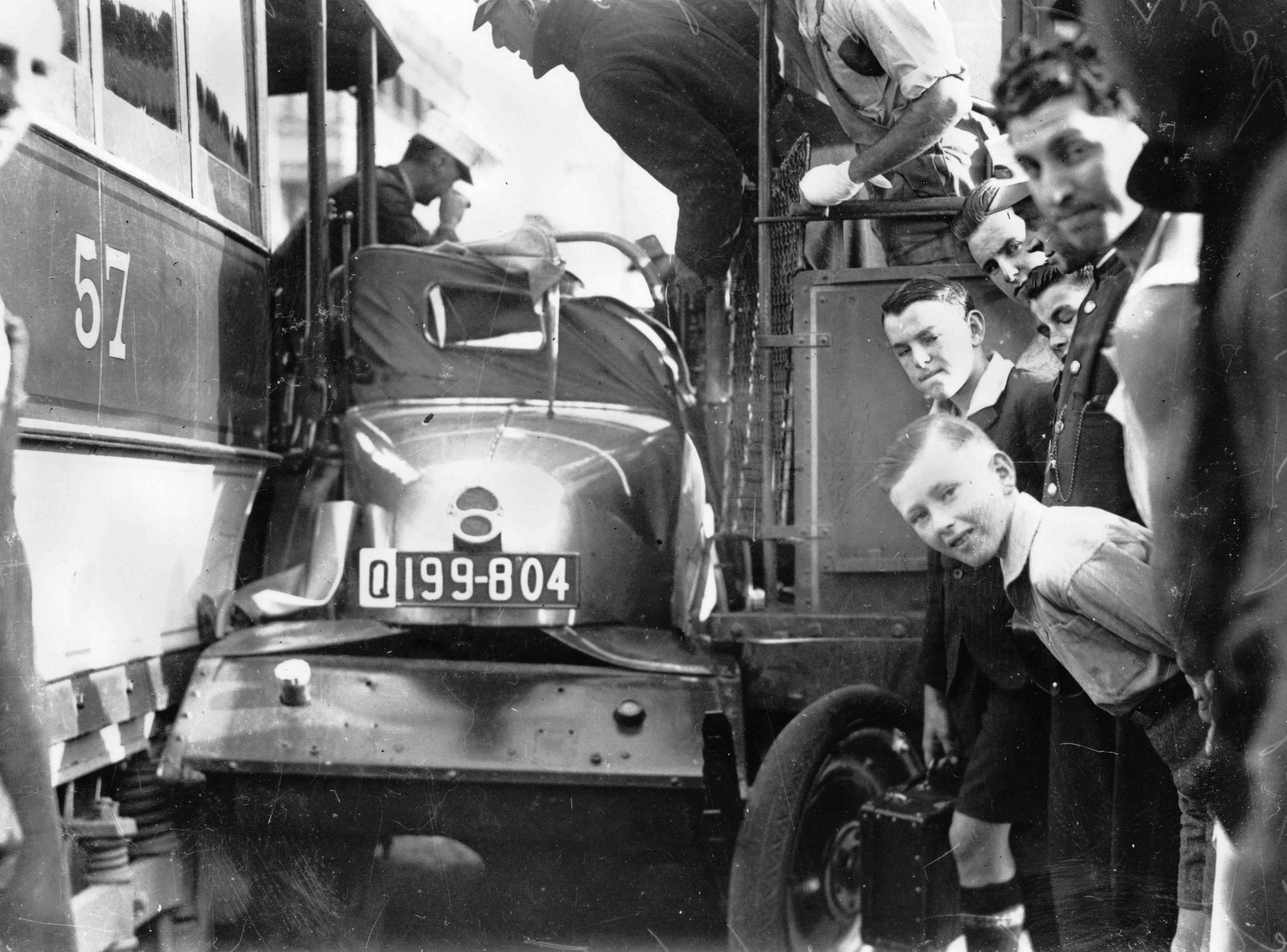
In 1935, the driver of this car swerved to avoid a New Farm tram in McLachlan Street, Fortitude Valley, only to be faced with another coming in the opposite direction. (State Library of Queensland)

Miss F. Harrold bought an Art Union ticket during a tram hold-up and won a Ford V8. (Telegraph 29th June 1935, Trove)
Trams also derailed from time to time. Whilst serious injuries were not common, tram traffic could be held up for extended periods. This sometimes had unexpected outcomes. In 1935, during a hold-up that delayed her trip home after work, Miss F. Harrold purchased a ticket in a Ambulance Art Union. Two weeks later she discovered that she’d won first prize which was a Ford V8 motorcar. At the time of the article, she hadn’t decided whether she would learn to drive.

Trams on the Victoria Bridge in 1940 waiting for a derailed tram to be removed. (State Library of Queensland)
On one occasion in 1911, a dreadnought style tram left the rails due to a mechanical failure while descending an incline on Milton Road. It crashed into a house where the residents were having breakfast. The shock disturbed some of the furniture in the house and stopped the clock. No one was injured.
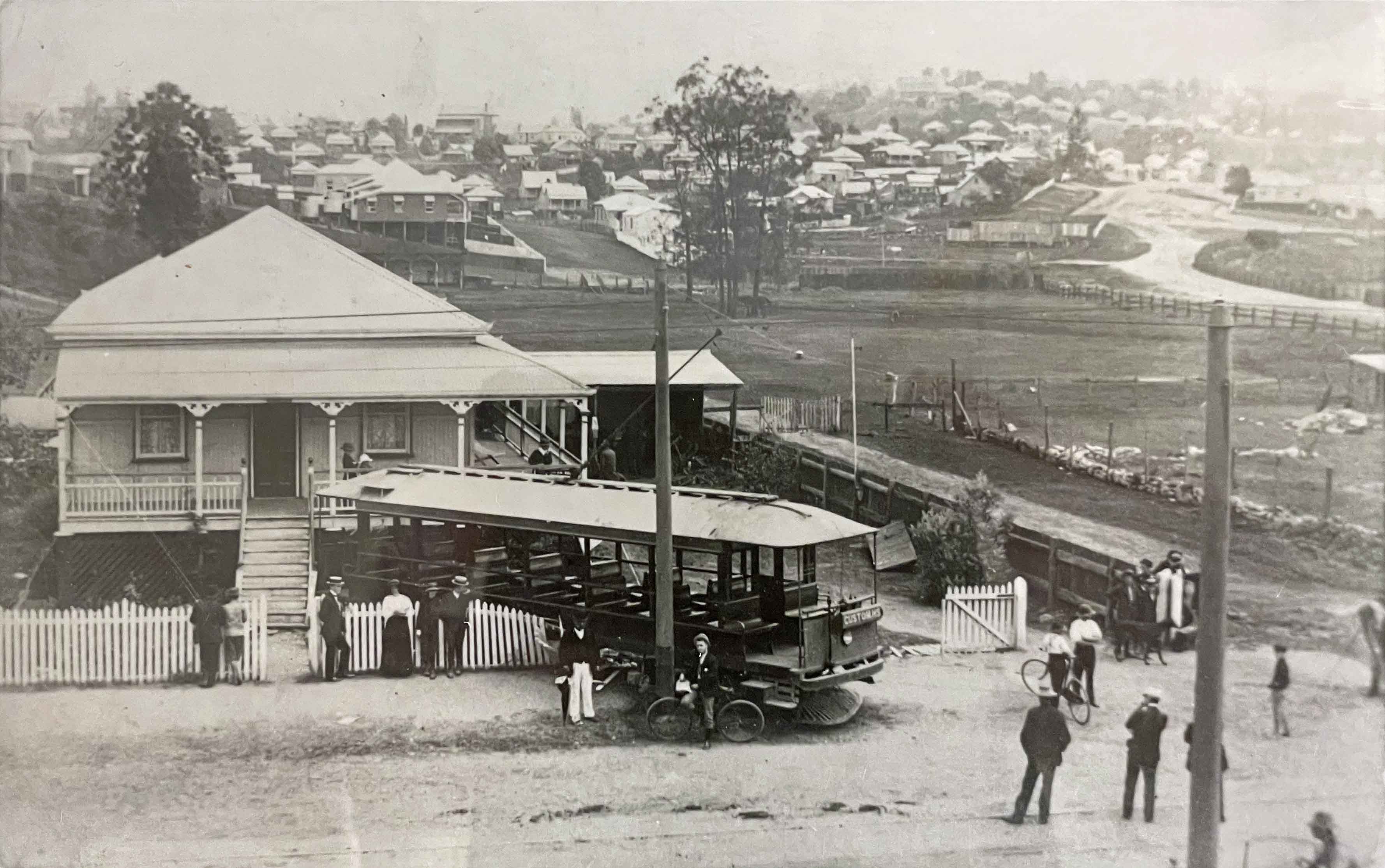
A derailed tram came to rest after knocking down the supporting post of the front stairs of this Milton house. (State Library of Queensland)
Young travellers
Stories of very young tram travellers illustrate changes in society over the last 70 years.
In April of 1947, 4 year old Marjorie Teresa Gates decided one evening that she wanted to see the pretty goldfish at the Botanical Gardens, so she walked from her home on Dornoch Terrace up to Gladstone Road and a caught a tram to the city. Later, at Woolloongabba Police Station, she told police her name but it was indistinct and she didn’t know her home address. After a sleep-over at the police station, they finally tracked down her family and after a hearty breakfast her grandfather arrived to take her home.

A pond at the Botanical Gardens.
Four years later, also in April, 3 year old Paul Tadman got bored at home and decided to go for a tram ride. He also ended up at Woolloongabba Police Station where the police weren’t able to get him to tell them his name. His mother reported him missing and Paul only started speaking when she arrived to collect him.

Telegraph, 18th April 1951.
Lost property
As with all public transport systems, the tramways had a continual flow of lost property. In later years, the lost property office was located underneath Centenary Place.
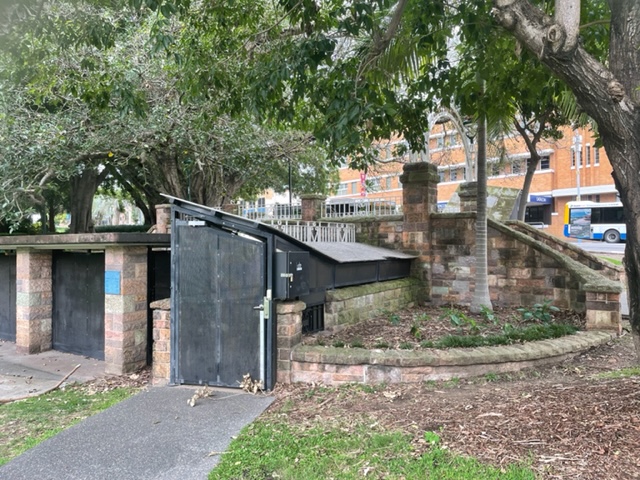
The former underground tramways lost property office in Centenary Place now houses traffic control equipment. (P. Granville)
Auction sales were held from time to time and newspaper reports of items on sale give us a view of a changing society. From the beginning of tram operation, umbrellas, parasols and bags were the most common lost property. However, many unusual items were left on trams over the years.
In 1901, a forgetful bank clerk embarrassedly collected a paper bag holding hundreds of pounds in bank notes that he’d left on an Ipswich Road tram.
In the 1920s, umbrellas and handbags remained the most common items, however car crank handles and side curtains had made an appearance, as well as garden tools, piano rolls and “sunshine purses”. A 1929 article mentions that some 30 articles a day were arriving at the lost property office including unusually a motor pump, large hammer and a bridal dress, “new but slightly damaged“.

Sunshine Purses for sale, Sydney Sun, 6 June 1920

Courier-Mail, 4th November, 1941. (Trove)
The 1930s saw fur chokers, silk stockings, tennis racquets, saws and an electric toaster. A report of a sale in 1947 commented that there were thousands of that still essential item of apparel, ladies’ gloves. They were sold in bundles at prices ranging from 5 to 8 shillings.
One distracted passenger on Christmas Day, 1940, sadly left “a pair of plump and juicy fowls, dressed for the oven” on a tram. A year later, a galah was found. The tramways manager commented ” If only it could talk or swear, it might be able to tell us where it lived.” The 1940s continued with unusual objects such as a human skull, later retrieved by a University medical student, a bag of false teeth and surgical corsets.

The forgetful medical student left this sign at his tram stop. (Courier-Mail, 27th September 1947, via Trove)
The conductor
The daily face of the Tramway Company was the conductor. Some became quite well known and in turn knew many of the regular passengers on their assigned route.

Some of a series of cartoons of conductors published in the “Truth” newspaper in 1910. (Trove)
Part of the conductor’s role was not only to sell tickets but also to check that passengers hadn’t travelled further than the validity of the ticket. This led at times to arguments and violence, especially when a passenger was ordered off a tram.
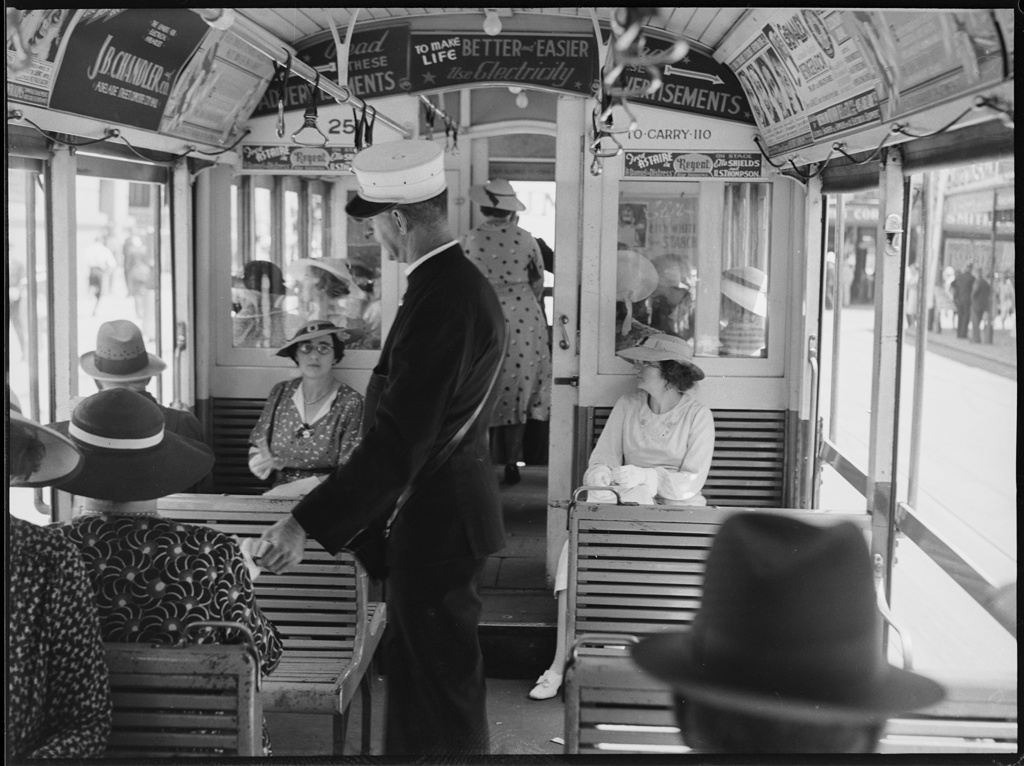
A conductor at work in 1938. (Ray Olsen, Mitchell Library)
A crowded tram made the conductor’s job very difficult. Young boys saw it as a game to avoid the conductor, and a favorite trick was to hide in the empty driver’s compartment at the rear of a tram on the rare occasions that the door hadn’t been locked correctly. I never managed to find an unlocked door but not for want of trying.

A crowded tram in 1937. (State Library of Queensland)
By the 1930s, evening trams were often well above their official maximum full load reportedly carrying some 140 passengers, making it physically impossible for the conductor to collect all the fares. Fare evasion reached such a level during World War Two that plain clothes inspectors were deployed. The older style of trams with footboards made it easier for “ticket jumpers”.

The “Brill” type of tram with footboards was in service up to the early 1950s. (State Library of Queensland)
The conductor was also responsible for signalling the motorman when it was safe to move off from a stop after all passengers had alighted or boarded.


There was a close camaraderie amongst conductors and motormen and there are newspaper reports over the years of funerals attended by large numbers of colleagues.

A Tramways funeral with a procession of employees preceding the hearse. This is possibly the funeral of J. Williams in September 1901. (State Library of Queensland)
The “foreign legion” style cap was part of the uniform until 1960.
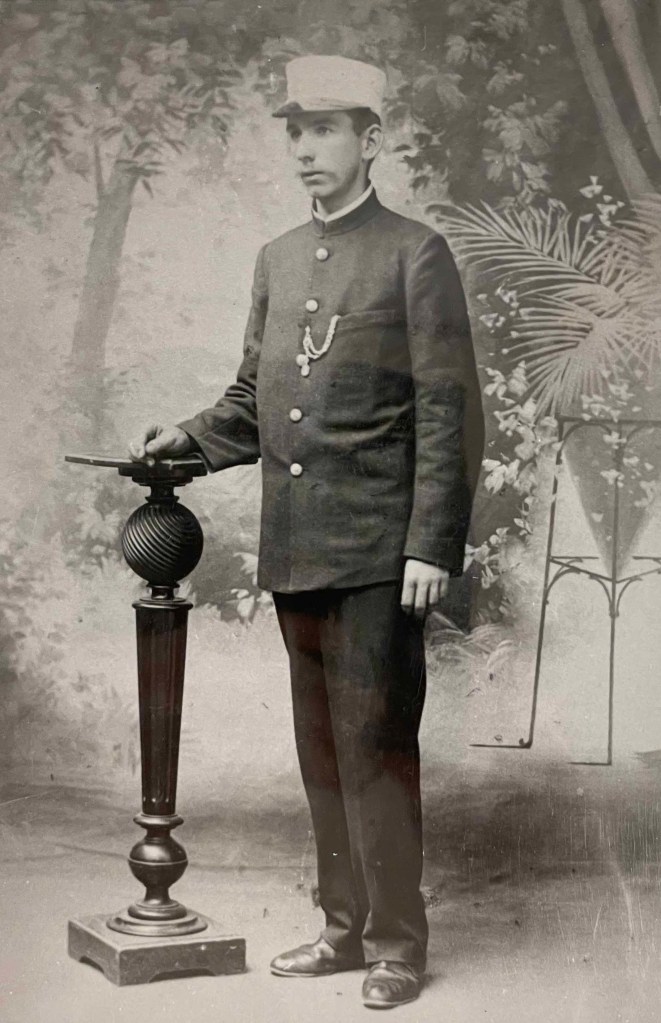


With many men serving in the armed forces during World War Two, jobs previously only available to men were filled by women. This included that of tram conductor.
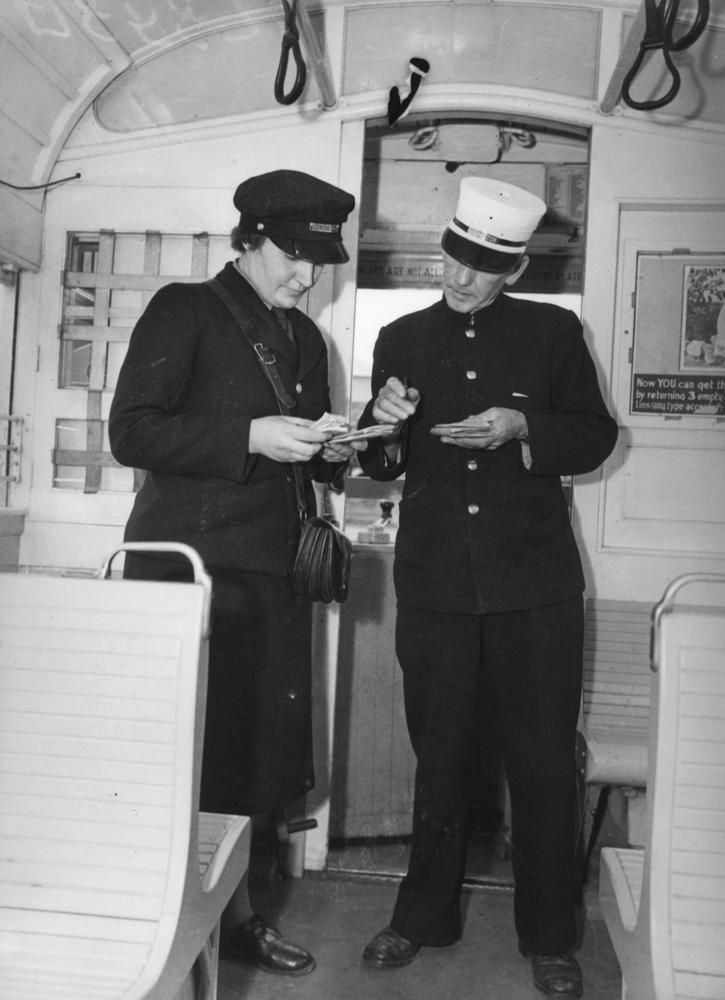
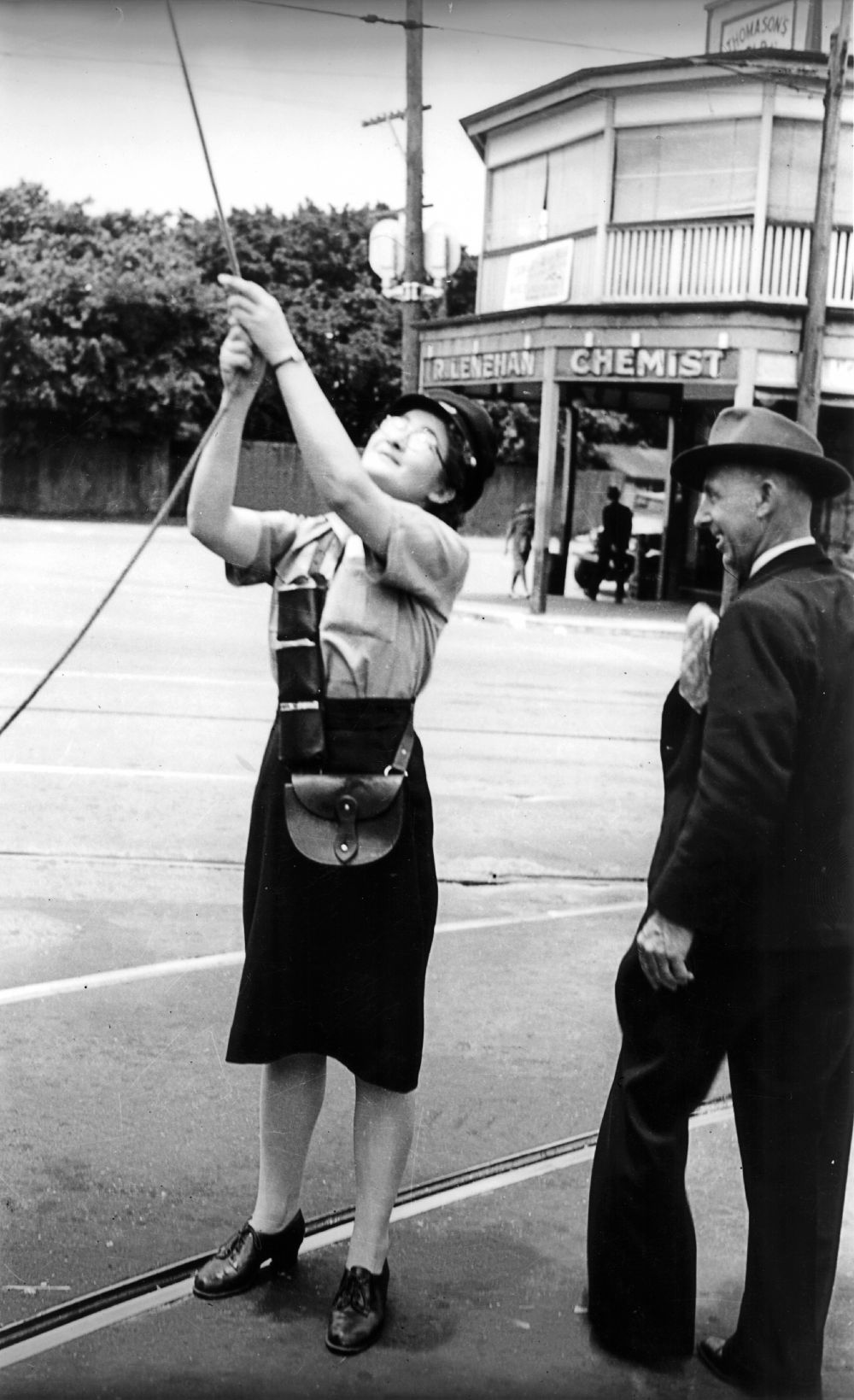
Eunice Bailey wasn’t expecting to find romance when she started work as a conductor, but in 1945 she married former inspector and depot master Hugh Low at the West End Methodist Church.

Depot master Hugh Low and conductor Eunice Bailey married in 1945. She is possibly the conductor pictured above at right.(Truth, Sunday 8th July, 1945)
After the closure of the tram system, some conductors were employed as ticket sellers at busy bus stops.

The demise of the Brisbane tram
Patronage of Brisbane’s tram system peaked at 148 million passenger journeys in 1946 and then steadily declined due to a number of changes such as increased car ownership, the development of suburban shopping malls and the lower cost of bus operation.
In 1962, a disastrous fire at the Paddington depot destroyed some 20% of the fleet and the last trams ran on the 13th April 1969.
Postscript – tram humour

Sunday Mail September 9, 1938.
Soon after the coronation, when crown pieces were in fairly common circulation, a man boarded a tram with five children in his wake. He offered one of these gargantuan coins.
‘Haven’t you anything smaller?’ asked the conductor. Pater Familiar, fondly regarding the bottom of the “steps and stairs” blandly replied: ‘Yes. but the baby’s still in hospital with his mother’.
Crowns, with a face value of 5 shillings or fifty cents, were minted only in 1937 and 1938. They were 38.5mm in diameter, somewhat larger than a 50 cent piece.
© P. Granville 2022





Well done! I have a lot of archival footage which may interest you. I also did two Channel seven documentaries on Clem Jones which included segments on the demise of the trams. My dad was a tram conductor and was ironically one of Clem’s Alderman who got rid of them!
LikeLiked by 1 person
Thanks Ian. The footage would be interesting . What I’d live to see but I think is lost is the film made by Sidney Cook in 1906 taken from a tram on Brisbane streets.
LikeLike
Thanks Paul, as always that is fascinating.
Bill
Dr William J Metcalf
Adjunct Lecturer, Griffith University,
Honorary Associate Professor, University of Queensland,
Brisbane, Australia
LikeLiked by 1 person
Thanks Bill
LikeLike
Enjoyed reading about Brisbane trams. When I was in Grade 5 our class travelled by tram from Mt Gravatt State School to Greenslopes State School for swimming lessons.
LikeLiked by 1 person
Thank you. This is informative.
LikeLiked by 1 person
Good one Paul
When our relatives from Mackay, Rockhampton and Warwick stayed with us at East Brisbane during World War Two we often took them on tram trips around Brisbane.
I recall one when at the Ascot terminus a Yank soldier bought a whole book of two penny tickets.
On another occasion an American soldier gave me a packet of American chewing gum. To j my surprise mum let me keep it.
LikeLiked by 1 person
Great memories John!
LikeLike